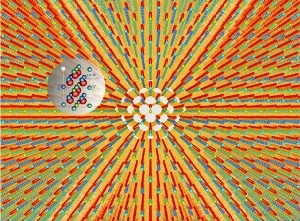Apr 2 2018
The suitability of kesterite-type semiconductors as absorber layers in solar cells can be improved by making specific modifications to their composition. A research team from the Helmholtz-Zentrum Berlin demonstrated this is specifically true for kesterites in which germanium was used as a substitute for tin. The researchers used neutron diffraction at BER II and other techniques for investigating the samples. The study has been chosen as the cover page of the latest issue of the CrystEngComm journal.
 The picture shows the typical arrangement of cations in a kesterite type structure. In the background the crystal structure is shown, a unit cell is highlighted. (Image credit: HZB)
The picture shows the typical arrangement of cations in a kesterite type structure. In the background the crystal structure is shown, a unit cell is highlighted. (Image credit: HZB)
Kesterites are semiconductor compounds made of the elements selenium, zinc, tin, and copper. Although these semiconductors can be used in solar cells as an optical absorber material, they could realize a maximum efficiency of only 12.6% to date, in contrast to solar cells made of copper-indium-gallium-selenide (CIGS) that have already achieved efficiencies of more than 20%.
Yet, kesterites are regarded to be exciting substitutes to CIGS solar cells since they are made of common elements, thereby avoiding any potential supply bottlenecks. A team headed by Professor Susan Schorr at the HZB has now analyzed a range of non-stoichiometric kesterite samples and provided insights into the connection between the composition and the optoelectronic characteristics. While producing the samples at the HZB, germanium was used as a substitute for the tin atoms.
Neutron Diffraction at BER II
Then, the team used neutron diffraction at BER II to examine these samples. Germanium, zinc, and copper can be differentiated from one another specifically well by using this technique, and their positions can be located in the crystal lattice. This leads to the synthesis of kesterites with the lowest disorder of copper-zinc as well as the lowest concentration of point defects, resulting in a slightly copper-poor and zinc-rich composition used in solar cells with the highest efficiencies.
The greater the enrichment of the composition with copper, the higher the concentration of other point defects deemed to be disadvantageous to the performance of solar cells. Further analyses revealed the relationship between the energy band gap, as it is known, and the composition of the kesterite powder samples.
The Effects of Germanium
This band gap is a characteristic of semiconductors and determines which frequencies of light release charge carriers within the material. We now know that germanium increases the optical band gap, allowing the material to convert a greater proportion of sunlight into electrical energy.
René Gunder, First Author
Kesterites: Candidate for Solar Cells and Photocatalysts
We are convinced that these kinds of kesterites are not only suitable for solar cells, but can also be considered for other applications. Kesterites acting as photocatalysts might be able to split water into hydrogen and oxygen using sunlight, and to store solar energy in the form of chemical energy.
Professor Susan Schorr